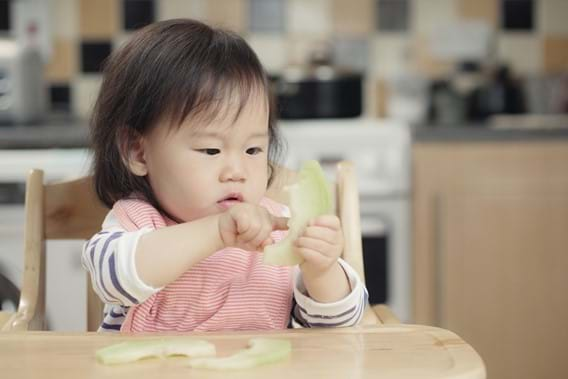
Beginners Guide to Baby-Led Weaning

Written by: Marjolaine Cadieux
Your baby is starting to develop an interest for food? You want to introduce solid foods, but don’t know where to start? Here’s a practical guide to help you and baby enter this new phase.
What Is Baby-Led Weaning?
Baby-led weaning (BLW) is to let an infant eat whole foods rather than purees when introducing solids. When applying this method, the child is the one to handle the food rather than being spoon-fed by a parent.
First and foremost, you need to decide if this diet is a good fit for you. Baby-led weaning is still a relatively new food progression method and scientific data on the matter is limited. However, several positive effects could be noted since this approach allows babies to discover foods (texture, colour, odour, etc.), eat the same things as the rest of the family (instead of purees), improve their fine motor skills, and learn to read their own hunger cues. Despite all this, there are a few cons to consider when opting for baby-led weaning. It’s finger food, so it’s bound to get messy. There’s also a risk of waste if your little one refuses to eat―go for smaller portions when this happens. Lastly, mealtime will last longer because babies need enough time to eat until they’re full.
Guiding Principles
If you feel this diet is a good match for you and baby, here are some pointers to make it work.
- Make sure you have a variety of foods at each meal. Ideally, target a protein (meat, tofu, legumes, etc.) and a fruit, a starchy food, a vegetable and a healthy fat.
- Change the food’s texture. Even if baby eats the same thing as the rest of the family during meals, make sure the food texture and shape are appropriate and safe.
Food
Preferable Texture(s)
Vegetables
Tender or well cooked, sticks or florets
Meat
Tender
Legumes
Puree or mixed into other foods
Wait 9 months old before giving them whole
Tofu
Sticks, big cubes or shredded
Fruits
Ripe, very soft
Bread
Crust or toasted
Cheese
Grated or big cubes
- Adapt the size of foods to the child’s age.
Age
Size of Food
6-7 months
Big sticks, strips, nuggets
Must stick out of the baby’s fist
7-8 months
Golf ball
9-12 months
Dice
- Avoid risky foods: thin-skinned fruits and vegetables, soft part of untoasted bread, whole grapes or cherry tomatoes, hard vegetables or fruits, raw or undercooked foods, whole nuts, sticky or hard foods, etc.
- Plan a little: again, BLW is often pretty messy. You might want to try a long-sleeve bib, a floor protector, let the baby eat in diapers or give smaller portions at a time. Otherwise, accept the occasional food spills.
Finally, remember that each child is different: what works for your first-born might not work for your second baby. So be patient and, most importantly, make sure BLW is right for your child.
Because baby-led weaning is new, it’s a good idea to seek help from a registered dietician or nutritionist, such as members of the Ordre professionnel des diététistes du Québec (OPDQ). These health specialists will offer personalized nutrition advice, such as what foods require extra vigilance, what foods should be avoided, what techniques to apply, and so forth. So don’t hesitate to book an appointment!
Marjolaine Cadieux, Dt.P., M.Sc
marjolainecadieuxnutrition@gmail.com
Reference: https://naitreetgrandir.com/fr/etape/0_12_mois/alimentation/fiche.aspx?doc=alimentation-autonome


